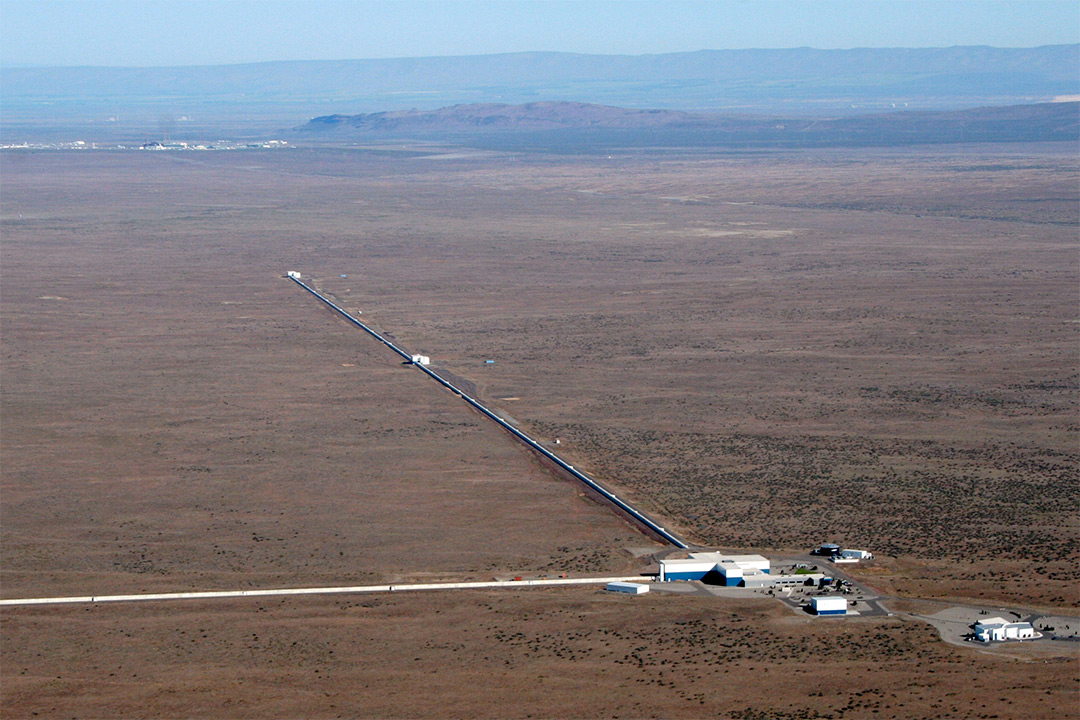RIT contributes to gravitational wave detection
LIGO Hanford Observatory
The LIGO Hanford Observatory in Washington is part of a network of ground-based detectors working in unison to identify and measure gravitational waves. Scientists at RIT's Center for Computational Relativity and Gravitation sift through data looking for these waves and, also, produce simulations of gravitational waves that can be used as blueprints for some of the signals.
Scientists at Rochester Institute of Technology anticipate ushering in the era of gravitational wave astronomy within the decade as part of the Laser Interferometer Gravitational-wave Observatory, or LIGO, Scientific Collaboration.
Members of RIT's Center for Computational Relativity and Gravitation, directed by Manuela Campanelli, professor in the School of Mathematical Sciences, are affiliated with the international collaboration that is searching for gravitational waves 100 years after Einstein’s theory of general relativity predicted them.
Gravitational waves are thought to hold information about the early universe and to result from massive collisions, explosions and fast-moving objects—such as black-hole mergers, supernova explosions, spinning compact stars—and the Big Bang.
The search for gravitational waves moved forward in September with the first observing run of the upgraded laser interferometer, Advanced LIGO. The pair of identical L-shaped observatories, located in Livingston, La., and Hanford, Wash., measure 2 1/2 miles. The detectors search for gravitational wave signals by observing interference patterns in laser light reflected off hanging mirrors. The finely tuned sensors measure small changes.
“The Advanced LIGO gravitational wave detectors represent a 10-fold increase in sensitivity from the Initial LIGO detectors, which concluded their last science run in 2010,” said John Whelan, associate professor in the School of Mathematical Sciences, member of the center and principal investigator of RIT's group in the LIGO Scientific Collaboration. “With initial LIGO, we were hoping to make the first direct detection of gravitational waves; with advanced LIGO, we anticipate that we will not only detect them, but begin to use them to observe the universe. This is the beginning of the era of gravitational wave astronomy.”
Whelan and Yuanhao Zhang, a graduate student in RIT’s astrophysical sciences and technology program, are searching for gravitational waves from Scorpius X-1, a neutron star in a low-mass X-ray binary system. Scorpius X-1 gives off X-rays as it accretes matter from a companion star.
They demonstrated the most sensitive search available for Scorpius X-1 during a recent mock-data challenge in preparation for Advanced LIGO’s scientific run. The neutron star is considered to be one of the most likely sources for long-lived gravitational waves in Advanced LIGO and Advanced Virgo, a forthcoming detector in Tuscany, Italy, Whelan said.
Taking a different approach, Richard O’Shaughnessy, assistant professor in the School of Mathematical Sciences, is spearheading RIT’s efforts in the search for gravitational waves from merging binaries of black holes and/or neutron stars. O’Shaughnessy and Jacob Lange, a graduate student in RIT’s astrophysical sciences and technology program, and several undergraduate researchers have developed and implemented techniques to infer the nature of coalescing binaries detected by LIGO from observed gravitational waves.
O’Shaughnessy’s team collaborates with Carlos Lousto, professor in RIT’s School of Mathematical Sciences and an American Physical Society Fellow, and James Healy, postdoctoral research fellow. Their simulations of black hole mergers are blueprints for modeling LIGO observations. O’Shaughnessy is optimistic about the prospects for Advanced LIGO’s observations.
“LIGO is now much more sensitive to transient ripples emitted from a pair of black holes as they coalesce because the volume in which we can detect has increased a thousand fold,” he said.”
RIT scientists who belong to the LIGO Scientific Collaboration include Campanelli,an American Physical Society Fellow, Lousto, Whelan, O'Shaughnessy and Hans-Peter Bischof, professor in the B. Thomas Golisano College of Computing and Information Sciences.
The National Science Foundation supports LIGO, which is jointly operated by the California Institute of Technology and the Massachusetts Institute of Technology.












